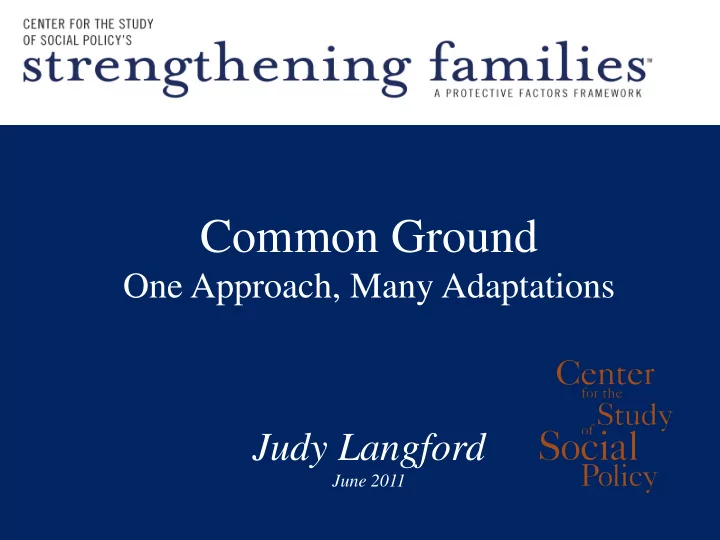

Common Ground One Approach, Many Adaptations Judy Langford June 2011
Mobilizing partners, communities and families to build family strengths, promote optimal development and reduce child abuse and neglect
THE STRENGTHENING FAMILIES APPROACH • Benefits ALL families • Builds on family strengths, buffers risk, and promotes better outcomes • Can be implemented through small but significant changes in everyday actions • Builds on and can become part of existing programs, strategies, systems and community opportunities • Is grounded in research, practice and implementation knowledge
In the beginning… .
PURPOSE: REDUCE CHILD ABUSE AND NEGLECT STARTING WITH CHILDREN 0-5 • The very highest rates of abuse and neglect occur for children under 4. This age group is a third of all children entering foster care and who are likely to stay the longest. • The brain’s primary architecture is developing in years 0-5, when family stability, skills and knowledge have the greatest impact on development. • Adverse experiences at an early age create lifelong risk for multiple problems; mitigating these traumas early is most effective.
PRAGMATIC STARTING POINTS • Find out what reduces child maltreatment, to point toward what programs should be building • Assume that all families are included • Start where families already have comfortable relationships, e.g. child care • Build on existing programs and strategies; don’t invent a new model
What we know: Families thrive when protective factors are robust in their lives and communities
FIVE PROTECTIVE FACTORS PARENTAL RESILIENCE SOCIAL CONNECTIONS KNOWLEDGE of PARENTING and CHILD DEVELOPMENT CONCRETE SUPPORT in TIMES of NEED SOCIAL and EMOTIONAL COMPETENCE of CHILDREN
Small but significant changes
KEY PROGRAM CHARACTERISTICS • Mental health consultation • Social emotional/conflict resolution curriculum • No expulsions • Fathers welcome • Consistent staff communication • Parent leadership
What happened next: A surprising leap from programs to policy
A FEW BRAVE INNOVATORS • Alaska • Arkansas • Illinois • Missouri • New Hampshire • Rhode Island • Wisconsin
VITAL NATIONAL PARTNERS PROVIDED “ LEGS”
Parent leaders, state agencies and local programs quickly adapted the framework -- beyond child abuse prevention for young children --to create a platform for linkages across service systems and a way of engaging informal opportunities for families.
ALIGNING RESULTS FOR FAMILIES
SERVICES IN PERSPECTIVE
FAMILIES TOOK LEADERSHIP • “at risk” families all families • risk factors protective factors/buffers to toxic stress • prevention promoting strong families and healthy development
Parental Resilience = Be strong and and flexible Social Connections = Parents need friends Know ledge of Parenting = Being a great parent is part natural and part learned Concrete Support = W e all need help som etim es Social and em otional developm ent for children = Help your children com m unicate and give them the love and respect they need
COMMUNITY CAFES - WASHINGTON • Parental Resilience = Courage • Social Connections = Community • Knowledge of Parenting = Health • Concrete Support = Freedom • Children’s Social and Emotional Development = Compassion
This surprising “self-organizing” tipping point was quickly supported by key national organizations, nimble federal partners and a small amount of foundation funding.
FEDERAL PARTNERS Administration for Children, Youth and Families: Children’s Bureau, Office on Child Abuse and Neglect Administration on Children and Families, Office of Child Care and Office of Head Start Maternal and Child Health Bureau (ECCS) Substance Abuse and Mental Health Services Administration (SAMHSA), local Project Launch sites Department of Defense, New Parents Program and Family Advocacy Program
STRENGTHENING FAMILIES NATIONAL NETWORK
Strengthening Fam ilies National Netw ork W A ME MT ND V OR MN N T H NY MA I D SD W I MI W Y RI CT PA I A NJ NV CA NE OH DE I L I N UT W V MD CO VA KS MO KY DC NC TN OK AZ NM AR SC AL MS GA TX LA AK FL HI
LEVERS FOR IMPLEMENTING AND SUSTAINING STRENGTHENING FAMILIES •Integration into policies and systems •Professional development •Real parent partnerships
NEW “ FAMILY VALUES” • Recognition of importance of families • Diminishing stigma and labeling • Acknowledging diversity among families • Reducing the distance between professionals and families • Partnerships among services and between services and people are essential • Everyone has a role and can play it!
www.strengtheningfamilies.net Judy Langford Center for the Study of Social Policy judy.langford@cssp.org
Questions?
Recommend
More recommend